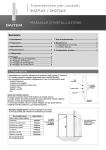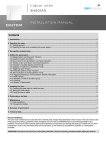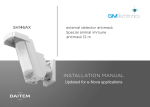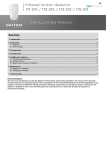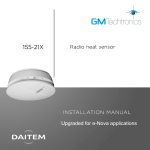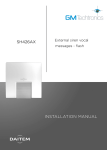Download Contact - eNova Upgrade - Mini Type - SH273AX
Transcript
Updated for e-Nova applications GB Contents 1. Introduction 1. Introduction .................... 57 IMPORTANT • Some functions are only available with versions 2.0.0 or later (press on the control panel keypad to check the version). • The operating differences with former ranges are described in the compatibility booklet available in the Daitem installers section at www.daitem.co.uk. 2. Preparation ..................... 58 2.1 Opening...................... 58 2.2 Power supply ............. 58 3. Programming.................. 59 4. Installing.......................... 60 4.1 Choosing the best place ............ 60 4.2 Fixing method and installing the magnet holder...... 61 The contact detector is used to protect openings such as doors & windows. It is fitted with a built-in magnetic contact (reed switch). LED indicator lamp 5. Testing ............................. 63 Test button 6. Maintenance................... 64 6.1 Battery low indication.................... 64 6.2 Changing the battery .................. 65 Screw cover Built-in magnetic contact 7. Technical data ................ 66 57 GB 2. Preparation Recommendations The user must not attempt to access the siren’s internal parts, except areas described in this manual. If the user does access these parts, the product guarantee will be considered null and void and DAITEM shall not be held responsible for any problems. Touching the siren’s internal parts and/or electronic components can damage the product. Furthermore, the siren is designed in such a way that these parts and components do not need to be accessed for operation or maintenance purposes. 2.2 Power supply The lithium battery pack is clipped into position (see diagram below). An arrow indicates which way to connect it. Lithium battery 2.1 Opening 1. Loosen the screws using a cross-head screwdriver. 2. Unclip the base plate cover. Alignment arrow LED Guarantee sticker: remove the pre-cut part of the sticker and stick it to the guarantee certificate in the user manual supplied with the control panel. If you are adding the siren to an existing system, use the guarantee sticker provided with this product. 58 When switched on the detector performs a self-test: the indicator lamp briefly lights up. GB 3. Programming During recognition programming, the product to be programmed for use with the control panel does not need to be placed next to it. In fact, we recommend you place the product at a short distance from the control panel (at least 2 meters away). Programming enables contact detectors to be recognised by the control panel. 1. To programme contact detectors the control panel must be in installation mode. If it is not, you will require the user’s master code, press: master code then press: 2. Programme the device as follows: “detector X” “group ?” “time delay?” “beep, detector X, group Y, immediate (or delayed or combined)” ))) )) to then 10 s max. Press ‹ then # on the control panel keypad Press and hold the “test” button until the control panel responds * to * according to the type of control panel The control panel waits for a group to be chosen (from 1 to 8)*. Choose the groups by pressing the corresponding numeral on the control panel keypad Choose the type of triggering: 0: immediate 1: delayed 2: combined Use the control panel keypad to select the type The control panel gives a voice message to confirm detector programming IMPORTANT: the control panel indicates an error by emitting 3 short beeps. When this happens programming should be carried out again. engineer installer code 59 GB • Example: programming of 1st detector allocated to Group 2 with immediate triggering. “detector 1” “group ?” “time delay?” “beep, detector 1 group 2, immediate” ))) )) then 10 s max. 4. Installing IMPORTANT: make sure there is a distance of at least 2 meters between each product, except between 2 detectors. 4.1 Choosing the best place The contact detector must be placed: • inside the protected area, • preferably on the door frame of the entrance to be protected at least 1 m above ground level, • far away from any sources of interference (electricity meter, metallic frame, etc.), • on a flat surface. IMPORTANT: when the detector is fixed to a metal support, insert a 20 mm thick wooden or plastic spacer between the base and the metal frame. 60 GB 4.2 Fixing method and installing the magnet holder Fix the back plate to the wall using 2 screws suitable for wall fixing. When the entrance is closed the magnet holder must be positioned opposite the built-in contact less than 5 mm away from it. 1. Align the vertical slot on the magnet holder with the arrow located on the base of the detector. 2. Adjust the height of the magnet holder according to the diagrams below. 3. Fix the magnet holder base, place the magnet inside the cover and clip it to the base. Max : 5 mm Max : 5 mm Magnet holder Detector Cover Magnet 35 mm slot-arrow alignment Spacers Base IMPORTANT: the parts must be laterally aligned and their height adjusted for the detector to operate correctly. Spacers Spacer If necessary use the spacer supplied for the magnet holder or position a spacer below the normally closed detector. 61 GB Overview of opening and closing distances between the contact detector and the magnet used by the built-in contact to analyse any change in entrance status. Built-in contact opening and closing distances Movement Contact status Wooden support t t Spacing opening 23 mm 22 mm closing 11 mm 11 mm Soft iron support t 4. Clip and then screw the detector to its base. Fit the screw head plug (supplied with the bunch of plastic parts for the magnet holder) to the cover. t t 24 mm 24 mm 19 mm closing 20 mm 9 mm 15 mm 8 mm opening 15 mm 12 mm 15 mm 12 mm closing 9 mm 7 mm 8 mm 6 mm To unclip the magnet holder cover, insert a small flat-headed screwdriver into the slot provided and turn. 62 t 34 mm t Horizontal sliding t opening 2,5 t Vertical sliding t Screw cover GB 5. Testing The contact detector has a “test” mode for testing: • the battery: the LED indicator lamp lights up when the test button is pressed to indicate the battery is working correctly, • detection: the LED indicator lamp lights up when the contact changes status, • the radio link: see § on Checking the radio links described in the control panel manual. IMPORTANT: the control panel must be in installation mode for testing. To test the detector: • press the test button and the detector changes to test mode for about 90 sec. After this period the detector automatically returns to normal operating mode, ! In accordance with the new functional requirements of EN50131-2-6, the LED is factory defaulted to be Inactive in Test Mode. To change this parameter, programme: about 10 sec. Commence the sequence by pressing the test button until the LED is off. 2 Press 2 times depending on the required parameter number. about 5 sec. Press and hold and then release the test button as soon as the LED lights for the 2nd time. 1 or 2 Press the test 1 or 2 times to select the required parameter. • 1: inactive • 2: active. 63 about 10 sec. Finish the programming by pressing the test button until the led is off. about 2 sec. LED lights for 2 seconds to confirm valid programming. GB • check detection of protected entrance opening and closing: entrance open: the test LED indicator lamp lights up entrance closed: the test LED indicator lamp goes out Pressing on the button for more than 1 sec. causes the control panel to give a “Test” message when the panel is in test or installation mode. “beep, test detector X, group Y immediate (or delayed or combined)” ))) )) 6. Maintenance 6.1 Battery low indication The control panel indicates when the contact detector’s battery is low. To check whether there is a problem with the detector battery, press on the detector’s test button. If the test LED indicator lamp no longer lights up, the lithium battery should be replaced. 64 GB 6.2 Changing the battery To change the battery: 1. switch the control panel to installation mode and ask the master user to press: then press: master code engineer installer code 2. open the detector casing (see § on Opening), 3. unclip the lithium battery pack, 4. wait 2 min. before replacing the flat lithium battery, 5. close the detector, 6. switch the control panel back to user mode, press: IMPORTANT: the detector’s configuration is saved when the battery is changed. engineer installer code • The lithium battery pack must be replaced by the same type of pack with the same technical characteristics, i.e. (3 V). • We advise you to use the DAITEM BatLi31 pack available in the catalogue in order to guarantee Li individual safety and equipment reliability. • Dispose of the waste lithium power pack in an appropriate recycling bin. Waste processing of electrical and electronic devices at the end of their service life (Applicable in European Union countries and other European countries with a waste collection system). Used on products or product packaging, this symbol indicates that the product must not be thrown out with household waste. It must be taken to a waste collection point for electrical and electronic product recycling. When you make sure that this product is disposed of in the most appropriate manner, you are helping to protect the environment and human health. If you would like additional information concerning the recycling of this product, please contact your town/city council, nearest waste collection centre or the shop where you bought the product. 65 GB 7. Technical data Specifications Built-in magnetic contact 1 Contact detector Environment building interior Power supply DAITEM lithium battery (BatLi31 - 3 V) Battery life 5 years in normal conditions of use Radio links TwinBand® 400/800 MHz Test button programming, battery and detection test LED Indicator lamp 1 Operating temperature -10 °C to +55 °C Anti-tamper & protection • against opening and removal • against loop cutting Degrees of mechanical protection IP 31/IK 04 Dimensions L x W x H 108 x 26 x 30 mm Weight (with battery) 60 g 66 GB To obtain advice when installing your system or before returning equipment, please contact the Daitem technical support team (see telephone number at the back of the alarm system installation manual) or check the web site at: www.daitem.co.uk A team of qualified technicians will advise you what to do. DECLARATION OF CONFORMITy 13 Manufacturer: Hager Security SAS Address: F-38926 Crolles Cedex - France Product type: Contact detector Trade mark: Daitem We declare under our sole responsibility that the product to which this declaration relates is compliant with the essential requirements of the following directives: • R&TTE Directive: 99/5/EEC • Low voltage directive: 2006/95/EC • Directive ROHS: 2002/95/EC in compliance with the following harmonised European standards: Products code EN 300 220-2 V2.3.1 EN 50130-4 (95) + A1 (98) + A2 (2002) EN 55022 & 55024 (2002) EN 60950 (2006) EN 301 489-1 V1.8.1 SH273AX X X X X X SH274AX X X X X X This product can be used in all EU, EEA Countries and Switzerland. Crolles, 08.04.2013 Signature: Patrick Bernard Director of Research and Development Non-contractual document, may be modified without prior notice. 67 805350/A - 04.2013













